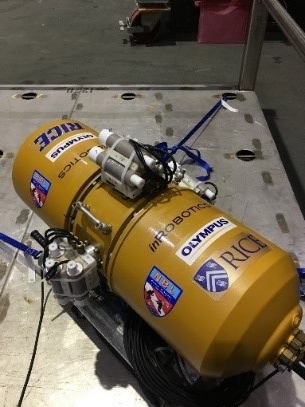Autonomous Underwater Vehicles (Update) Investigator: Fathi Ghorbel
Researchers at Rice University have been working on improvements to the next generation of autonomous underwater vehicles (AUVs), with the emphasis on making them capable of physical operations and exploration with high maneuverability in subsea environments. This is especially important for subsea energy application, which is characterized by a tight workspace (compared to the open sea) and the need to perform physical operations with energy structures while maintaining full autonomy.

Researchers watch underwater view of AUV maneuvering at the NBL
Principal investigator, Fathi Ghorbel and his research team, have successfully fabricated and tested their swimming robot AUV at the National Aeronautics and Space Administration (NASA) Johnson Space Center’s Neutral Buoyancy Lab (NBL). Conducted in April 2018, the test required the construction of an underwater structure to recreate the conditions of an oil tank.
In this demonstration and in his research project, Ghorbel focused on two main inspection types. The first inspection type required the AUV to swim as if it were entering inside an oil tank to inspect the sealing of the floating roof. The second, necessitated the AUV to crawl across the floor as if to inspect an oil tank’s health (thickness and existence of cracks and metal defects). Due to the AUV’s 6 degrees of freedom ability and newly developed thrusters that are amenable to tight feedback control, the robot successfully performed both maneuvers and physical interactions to emulate those in real oil tanks.

Prior to submerging underwater, the AUV is placed on the lift
Looking to influence the next generation of AUVs, the research team emphasizes the need for a design that is capable of maneuvering in tight spaces and highlight the importance of the robot’s capability of slow swimming (low Reynolds number), docking, and breaking motion. Equally important, will be the AUVs ability to perform forceful interaction with the workspace structures. All of these requirements represent major challenges in robotic thrusting, localization and mapping, and forceful interaction, of which Ghorbel’s team has successfully demonstrated through the AUV’s testing at NASA’s NBL. Video of the AUV testing will be made available for public view later this year.